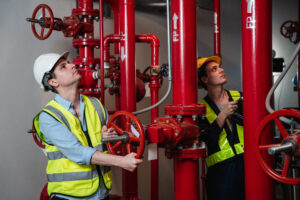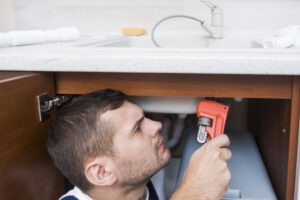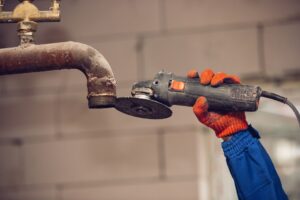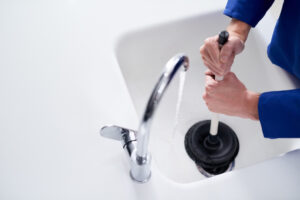How to Prevent Pipes from Freezing in Oklahoma Winter
When the temperature drops to sub-freezing temperatures, the water in your pipes freeze and expands. The expansion creates enough pressure in the plumbing to burst a pipe. Once the pipe bursts, water quickly leaks into the surrounding area. Flooding and water damage can occur, leading to structural damage.
There are several things you can do to prevent pipes from freezing or bursting during the harsh Oklahoma winter. Below, we provide a guide that protects your pipes from winter weather. If you have further questions or need to schedule a plumbing inspection, contact Infinity Plumbing Services.
Allowing warm air to circulate through your entire house keeps the pipes warm and prevents them from bursting. Check all the vents in your house to make sure they are open. Also, feel each vent to make sure warm air is coming out. If not, you may need to schedule an air duct cleaning to remove any blockage in your ductwork.
Keep in mind that you do not have to open up all the cabinets. Instead, focus on the cabinets that contain fixtures, pipes, or drains. Doing so isolates the warm air to the pipes instead of the entire cabinet area. Open the cabinets any time the temperature falls below 32 degrees outside for more than three hours. It may just prevent a burst pipe.
Allowing your faucets to drip keeps a steady stream of warmer water flowing, preventing cold water from freezing and potentially bursting the pipes. When turning the faucet on, use the cold water and reduce the flow to a light but steady drip. You don’t have to turn on the hot water or let the water flow full blast. Doing so will run up your water bill.
Here are some things to consider when applying heating tape to pipes:
If your plumbing system does not have an accessible shutoff valve, you may want to schedule a professional plumbing installation. A certified plumber can assess your current plumbing system and install an easy-to-use water valve that you can access and shut off quickly. You can customize your installation based on your plumbing system design.
Fill out our contact form or call us to schedule plumbing services in Tulsa, Oklahoma.
There are several things you can do to prevent pipes from freezing or bursting during the harsh Oklahoma winter. Below, we provide a guide that protects your pipes from winter weather. If you have further questions or need to schedule a plumbing inspection, contact Infinity Plumbing Services.
1. Circulate Warm Air in Every Room
One of the most common myths in home heating is that closing doors and vents will help you concentrate more warm air in a designated area. The truth is that closing off doors and vents prevents proper air circulation. As a result, some rooms or areas never receive the warm air they need. Many of these rooms have pipes nearby.Allowing warm air to circulate through your entire house keeps the pipes warm and prevents them from bursting. Check all the vents in your house to make sure they are open. Also, feel each vent to make sure warm air is coming out. If not, you may need to schedule an air duct cleaning to remove any blockage in your ductwork.
2. Open the Doors to Your Cabinet
If your sinks are near an outside wall, it’s a good idea to leave your cabinet doors open so warmer air can flow near the pipe. Leaving your cabinet doors open allows room temperature air to keep your pipes warmer. With the doors closed, your pipes are essentially sealed-in with the cold outdoor air, like a refrigerator.Keep in mind that you do not have to open up all the cabinets. Instead, focus on the cabinets that contain fixtures, pipes, or drains. Doing so isolates the warm air to the pipes instead of the entire cabinet area. Open the cabinets any time the temperature falls below 32 degrees outside for more than three hours. It may just prevent a burst pipe.
3. Turn on a Dripping Faucet
There is a difference in air temperature and groundwater temperature, with groundwater temperature typically being warmer during winter. For instance, if the temperature outside is 30 degrees, the groundwater temperature is closer to 40 to 50 degrees. The warmer water temperature can prevent pipes from bursting in sub-freezing temperatures.Allowing your faucets to drip keeps a steady stream of warmer water flowing, preventing cold water from freezing and potentially bursting the pipes. When turning the faucet on, use the cold water and reduce the flow to a light but steady drip. You don’t have to turn on the hot water or let the water flow full blast. Doing so will run up your water bill.
4. Wrap Your Pipes with Insulation
Insulating pipes is a simple but effective way to prevent them from freezing this winter. Follow these tips for insulating your pipes.- Insulate pipes in your home’s crawl spaces, attic, and garage. These exposed pipes are most susceptible to freezing. The more insulation you use, the better protected your pipes are.
- Wrap pipes with heat tape or thermostatically controlled heat cables. Be sure to follow all manufacturers’ installation and operation instructions.
- Seal leaks that allow cold air inside, near where pipes are located (i.e. around electrical wiring, dryer vents, other pipes), with caulk or insulation. When it’s extremely cold, a tiny opening can let in enough cold air to cause a pipe to freeze.
5. Purchase Some Heating Tape
Heat tape prevents metal and rigid plastic pipes from freezing. In sub-freezing areas, heat tape is one of the most popular ways to protect pipes from freezing because it’s affordable and works remarkably well. Heat tape isn’t sticky. It is a simple resistive heat-conducting flexible wire that uses electricity to produce heat. This heat source is held close against your vulnerable water lines and keeps the water from freezing.Here are some things to consider when applying heating tape to pipes:
- Make sure the heating tape is appropriate for the plumbing material in your home.
- Use low-temperature heating tape for plumbing systems in older mobile homes.
- Avoid using heat tape around aluminum wiring.
- Only use heating tape when the temperature outside is below freezing.
- Follow manufacturer specifications when installing heating tape.
6. Turn Off the Water Supply Valve
Your house should have a water supply valve somewhere on the main supply line. If you do not plan to use the water when it is freezing outside, you can shut off the water supply valve. Doing so prevents water from flowing through your entire plumbing system. Pipes with no water will not freeze or burst. Turn on all faucets and let the remaining water drain out after you turn off the water supply valve.If your plumbing system does not have an accessible shutoff valve, you may want to schedule a professional plumbing installation. A certified plumber can assess your current plumbing system and install an easy-to-use water valve that you can access and shut off quickly. You can customize your installation based on your plumbing system design.
Schedule a Plumbing Inspection in Tulsa, Oklahoma
Winter is on the way. Is your plumbing system protected from high winds, low temperatures, and ice storms? If not, now is the time to schedule a plumbing assessment from Infinity Plumbing Services. We offer professional plumbing inspections in Tulsa, Oklahoma. Contact us today to get an in-home assessment and estimate on plumbing repair or repiping.Fill out our contact form or call us to schedule plumbing services in Tulsa, Oklahoma.





